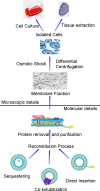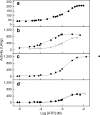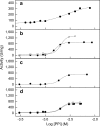Proteoliposomes in nanobiotechnology
- PMID: 28510001
- PMCID: PMC5418368
- DOI: 10.1007/s12551-011-0065-4
Proteoliposomes in nanobiotechnology
Abstract
Proteoliposomes are systems that mimic lipid membranes (liposomes) to which a protein has been incorporated or inserted. During the last decade, these systems have gained prominence as tools for biophysical studies on lipid-protein interactions as well as for their biotechnological applications. Proteoliposomes have a major advantage when compared with natural membrane systems, since they can be obtained with a smaller number of lipidic (and protein) components, facilitating the design and interpretation of certain experiments. However, they have the disadvantage of requiring methodological standardization for incorporation of each specific protein, and the need to verify that the reconstitution procedure has yielded the correct orientation of the protein in the proteoliposome system with recovery of its functional activity. In this review, we chose two proteins under study in our laboratory to exemplify the steps necessary for the standardization of the reconstitution of membrane proteins in liposome systems: (1) alkaline phosphatase, a protein with a glycosylphosphatidylinositol anchor, and (2) Na,K-ATPase, an integral membrane protein. In these examples, we focus on the production of the specific proteoliposomes, as well as on their biochemical and biophysical characterization, with emphasis on studies of lipid-protein interactions. We conclude the chapter by highlighting current prospects of this technology for biotechnological applications, including the construction of nanosensors and of a multi-protein nanovesicular biomimetic to study the processes of initiation of skeletal mineralization.
Keywords: Alkaline phosphatase; Biomineralization; Biotechnology; Leishmaniasis; Na,K-ATPase; Nanosensor; Proteoliposomes.
Figures




Similar articles
-
Biophysical aspects of biomineralization.Biophys Rev. 2017 Oct;9(5):747-760. doi: 10.1007/s12551-017-0315-1. Epub 2017 Aug 29. Biophys Rev. 2017. PMID: 28852989 Free PMC article. Review.
-
Lipid composition modulates ATP hydrolysis and calcium phosphate mineral propagation by TNAP-harboring proteoliposomes.Arch Biochem Biophys. 2020 Sep 30;691:108482. doi: 10.1016/j.abb.2020.108482. Epub 2020 Jul 22. Arch Biochem Biophys. 2020. PMID: 32710882 Free PMC article.
-
Na,K-ATPase reconstituted in liposomes: effects of lipid composition on hydrolytic activity and enzyme orientation.Colloids Surf B Biointerfaces. 2005 Apr 10;41(4):239-48. doi: 10.1016/j.colsurfb.2004.12.013. Colloids Surf B Biointerfaces. 2005. PMID: 15748819
-
Reconstitution of the Neurospora crassa plasma membrane H(+)-adenosine triphosphatase.Biochim Biophys Acta. 1995 May 24;1236(1):95-104. doi: 10.1016/0005-2736(95)00028-2. Biochim Biophys Acta. 1995. PMID: 7794959
-
Proteoliposome as the model for the study of membrane-bound enzymes and transport proteins.Mol Cell Biochem. 1983;50(1):3-15. doi: 10.1007/BF00225276. Mol Cell Biochem. 1983. PMID: 6221188 Review.
Cited by
-
Effects of pH on the production of phosphate and pyrophosphate by matrix vesicles' biomimetics.Calcif Tissue Int. 2013 Sep;93(3):222-32. doi: 10.1007/s00223-013-9745-3. Epub 2013 May 31. Calcif Tissue Int. 2013. PMID: 23942722 Free PMC article.
-
Drug-induced activation of integrin alpha IIb beta 3 leads to minor localized structural changes.PLoS One. 2019 Apr 12;14(4):e0214969. doi: 10.1371/journal.pone.0214969. eCollection 2019. PLoS One. 2019. PMID: 30978226 Free PMC article.
-
Liposomal systems as carriers for bioactive compounds.Biophys Rev. 2015 Dec;7(4):391-397. doi: 10.1007/s12551-015-0180-8. Epub 2015 Oct 10. Biophys Rev. 2015. PMID: 28510100 Free PMC article. Review.
-
Proteoliposomes with the ability to transport Ca(2+) into the vesicles and hydrolyze phosphosubstrates on their surface.Arch Biochem Biophys. 2015 Oct 15;584:79-89. doi: 10.1016/j.abb.2015.08.018. Epub 2015 Aug 29. Arch Biochem Biophys. 2015. PMID: 26325078 Free PMC article.
-
Oversized nanodiscs for combined structural and functional investigation of multicomponent membrane protein systems.Sci Rep. 2025 Aug 8;15(1):29070. doi: 10.1038/s41598-025-15035-3. Sci Rep. 2025. PMID: 40781353 Free PMC article.
References
-
- Albers RW. Biochemical aspects of active transport. Ann Biochem. 1967;36:727–756. - PubMed
-
- Alves JB, Ferreira CL, Moreira AF, Silva GA, Alves GD, Paulino TP, Ciancaglini P, Thedei G, Jr, Napimoga MH. Local delivery of EGF-liposome mediated bone modeling in orthodontic tooth movement by increasing RANKL expression. Life Sci. 2009;85(19–20):693–699. - PubMed
Publication types
LinkOut - more resources
Full Text Sources

